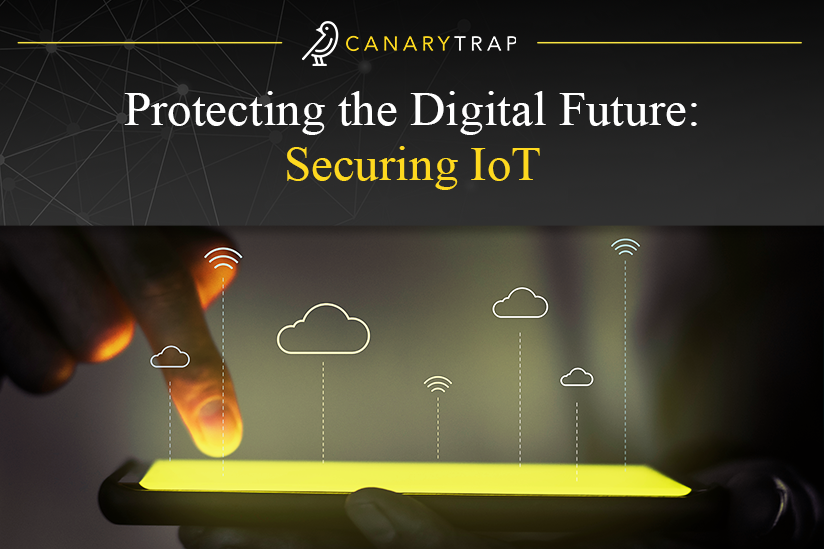Protecting the Digital Future: Securing IoT
- July 28, 2023
- Canary Trap
In today’s hyper-connected world, the Internet of Things (IoT) has emerged as a transformative force, revolutionizing industries and enhancing our daily lives. IoT devices, ranging from smart home appliances to industrial sensors, have empowered businesses and consumers alike with unprecedented convenience and efficiency. However, as the IoT landscape expands rapidly, so does the concern for security. In this blog, we will explore the importance of IoT, its benefits, the pivotal role of security in IoT, the risks and challenges it presents, and practical steps to secure IoT devices effectively.
The Importance and Benefits of IoT
The Internet of Things has become a fundamental aspect of modern life, driving innovation and transforming various sectors. By connecting everyday devices and systems to the internet, IoT enables seamless data exchange, automation, and intelligent decision-making. The benefits of IoT are far-reaching. According to an article published by RS Online, some of these benefits include:
- “Improved Efficiency. By improving efficiency, it enables you to make smarter, more informed decisions.
- Reducing Costs. Replacing unnecessary maintenance with more efficient, personalized, predictive maintenance.
- Upgrades. Optimized process aid with better communication and remotely controlling operations to identify risks and inefficiencies.
- Limiting Inventory Costs. Automated inventory management can help by reducing human error and facilitating logistics operations.
- Maintenance. Anticipating maintenance requirements on production lines, reduces the risk of sudden breakdown or equipment failure.
- Monitoring. Helps evaluate the efficiency and productivity of supply chains, equipment, devices, and systems.
- Competitive Advantage. Achieved by facilitating data-driven decisions and enabling new or optimized business models.”
An interconnected world enables businesses to optimize operations, enhance customer experiences, and unlock new revenue streams. The power of IoT lies in its ability to collect, analyze, and act upon data from diverse sources, driving intelligent decision-making and business growth.
Risk and Challenges of IoT
While IoT presents numerous advantages, it also introduces significant risks. The proliferation of IoT devices, from smart home devices to industrial sensors, has opened new attack vectors for cybercriminals as every connected endpoint can be a potential entry point for hackers.
In an article by The Daily Scanner, they listed some of the most significant security challenges of IoT:
- “Device Standardization. The vast number and variety of IoT devices make it challenging to standardize security protocols that work across all devices.
- Limited Hardware & Software. Many devices are designed with limited computational power, making it difficult to implement strict security measures.
- Access Control. IoT devices are often connected to other devices and networks, creating potential vulnerabilities and attack vectors for cybercriminals.
- Data Encryption. IoT devices collect and store personal and financial data, and other sensitive information that can be used for identity theft, fraud, or other attacks.
- Monitoring and Maintenance. The rapid pace of technological change makes it challenging to keep up with emerging security threats and vulnerabilities.”
Security vulnerabilities in IoT devices can lead to data breaches, privacy infringements, unauthorized access, and even physical safety risks. In addition, the scale and diversity of IoT devices and the lack of uniform standards and regulations can further exacerbate these security challenges.
The role of Security in IoT
Security must be an integral part of IoT design, development, and implementation. This involves ensuring that devices and networks are protected from vulnerabilities, data is encrypted, user privacy is preserved, and access controls are robust. The secure implementation of IoT is a shared responsibility among manufacturers, developers, service providers, and end-users.
In an article by Ordr, experts added: “In some ways, IoT security mirrors the strategies associated with traditional network security, but the sensitivity of the data that IoT devices collect, and the systems they manage, means that the stakes of IoT security are greater. An IoT device that can shut down a power plant or collect video of a family inside its home demands greater security controls than a traditional PC or laptop.
Security must be at the core of any IoT initiative. Organizations need to adopt a security-first mindset and incorporate security measures throughout the entire IoT lifecycle, from device design to ongoing maintenance.
Regarding the adoption of IoT devices on businesses’ networks, the experts at Ordr added: “Many organizations aren’t even aware of all the devices connected to their networks. “Shadow IoT” refers to unmanaged and unseen devices—such as employees’ cell phones or smart watches, or devices set up for testing and then forgotten—connected to the network that can present a huge security risk. As many as 20% of all connected devices may be shadow IoT.”
Best practices and recommendations to secure IoT devices
The first step in ensuring IoT security is recognizing its criticality. Understanding the potential risks associated with compromised IoT devices can lead to data breaches, privacy violations, and even physical safety concerns. That’s why IoT security should be approached proactively to safeguard both personal and organizational assets.
Securing IoT devices is not just about protecting data; it’s about preserving the safety and privacy of users. As the number of connected devices grows, so does the need for strong security measures. Some of the most common best practices to secure IoT include:
- Use of Unique and Strong Passwords.
Strong and unique passwords are the first defense against hackers. Organizations should make sure to change all default passwords immediately and create unique passwords for each device without repeating them. Although that might make the passwords difficult to remember, password managers can be used to create and manage complex passwords for multiple devices.
As mentioned in an article by TechTarget, “Using a common and simple password for IoT devices means opening the front door for hackers. If a hacker can guess one of your passwords, it could harm every device you own that uses that password.”
- Device Authentication and Authorization.
Implementing strong authentication mechanisms, such as two-factor authentication will help ensure that only authorized users can access IoT devices and data. Multi-factor authentication is a powerful security measure that significantly reduces the risk of unauthorized access and strengthens the overall security posture of IoT devices.
“Multi-factor authentication (MFA) is your backup if your password fails, either because it was in a data leak or an attacker figured it out through brute force. Like other security measures, the complexity and number of authentication steps you add should correlate to your threat model and the level of security you’re after”, added IoT expert Eleanor Bennett in an article by IoT For All.
- Securing All Communication Channels.
Encrypting data transmission between IoT devices and cloud servers is a great measure to protect against eavesdropping and man-in-the-middle attacks. End-to-end encryption is essential to secure data transfer in IoT environments, because it ensures that sensitive information remains confidential and integral throughout its journey.
- Keeping Up with Regular Software Updates.
Organizations need to ensure that IoT devices receive timely and automatic software updates to patch known vulnerabilities and enhance security features. Timely software updates are critical to addressing security flaws and reducing the risk of exploits and regular patching is a fundamental aspect of IoT security.
As it was pointed out in an article published in Make Use Of, “Unpatched vulnerabilities can be an entry point for hackers to access IoT devices. So, install all firmware updates as soon as they are available, and ensure you’re downloading updates from the device manufacturers’ websites.”
- Securing Boot and Firmware Integrity.
Secure boot processes can be implemented to verify the integrity of the device’s firmware, preventing unauthorized modifications. Firmware integrity checks during boot-up can help ensure that only authorized and unaltered software runs on IoT devices. This strengthens the device’s defenses against tampering and unauthorized access.
- Securing IoT Gateways
Strengthening security at IoT gateways is key, because they act as intermediaries between devices and the cloud. That’s why it’s necessary to apply strict access controls and encryption. An IoT gateway serves as the first line of defense for the connected ecosystem, which means that securing them is critical to not only prevent unauthorized access, but also data breaches.
- Data Encryption and Storage.
Encrypting sensitive data at rest and in transit to safeguard user information also helps prevent unauthorized access to critical data. This is considered an essential measure to protect IoT data, because it ensures that even if data is intercepted, it remains unreadable and unusable to unauthorized parties.
- User Awareness and Education.
Educating users about the importance of strong passwords, security practices, and how to recognize phishing attempts or suspicious activities related to IoT devices is one of the most important security measures an organization can make. End-users are often the weakest link in IoT security. Raising awareness and providing training can empower users to adopt secure practices and contribute to a safer IoT environment.
- Implementation of Network Segmentation.
Network segmentation is a proactive security measure that contains potential breaches and prevents attackers from gaining access to critical systems. IoT devices can be segmented into separate networks to limit the potential impact of a security breach and prevent lateral movement by attackers.
Eleanor Bennet from IoT For All also adds: “A flat network, where all devices are connected—including IoT and employee devices—are often protected by a firewall or endpoint protection and detection software. In the case of a successful cyberattack, the attacker gains access to the entirety of the network. Network segmentation prevents that by minimizing damages and limiting the attack area. It also allows you to focus on limited security resources on segments with the most critical data.”
- Keeping Up With Compliance and Standards.
It’s necessary to adhere to industry standards and compliance regulations to maintain the security and privacy of IoT devices and data. Compliance with industry regulations ensures that IoT solutions meet essential security requirements and maintain user trust.
- Regular Security Audits and Testing.
In order to identify vulnerabilities and weaknesses in the IoT infrastructure, organizations need to conduct frequent security audits and penetration testing, as periodic security assessments are crucial to identifying and addressing new threats and emerging vulnerabilities in IoT systems.
In Conclusion
The Internet of Things is a transformative force that is shaping the way we interact with technology and the world around us. However, the success of IoT relies heavily on its security. By understanding the importance of IoT, its benefits, and the potential risks, organizations and individuals can take proactive steps to secure IoT devices effectively. With a comprehensive approach to security that incorporates best practices, industry standards, and user awareness, we can ensure a safer and more resilient IoT ecosystem for the future. Together, we can embrace the potential of IoT while safeguarding its promise with robust security measures. As IoT continues to evolve, the focus on security will remain paramount to unlock its full potential while mitigating risks in the ever-expanding connected world.
SOURCES:
- https://uk.rs-online.com/web/content/discovery/ideas-and-advice/iot-advantages
- https://www.dailyscanner.com/ensuring-iot-security-implementation-challenges-and-solutions/
- https://ordr.net/article/iotsecurity/
- https://www.techtarget.com/iotagenda/post/How-to-secure-IoT-devices-and-protect-them-from-cyber-attacks
- https://www.iotforall.com/how-to-secure-iot-devices-2
- https://www.makeuseof.com/ways-keep-iot-devices-secure/

